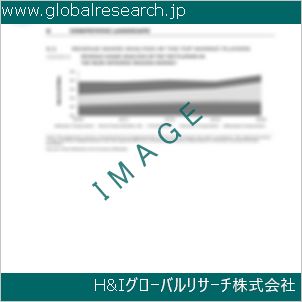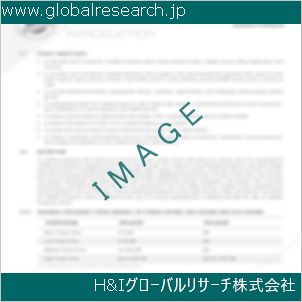Table of Contents
1 Industry Overview of Potassiumiodate
1.1 Definition and Specifications of Potassiumiodate
1.1.1 Definition of Potassiumiodate
1.1.2 Specifications of Potassiumiodate
1.2 Classification of Potassiumiodate
1.3 Applications of Potassiumiodate
1.3.1 Nuclear Application
1.3.2 Non-Nuclear Application
1.4 Industry Chain Structure of Potassiumiodate
1.5 Industry Overview and Major Regions Status of Potassiumiodate
1.5.1 Industry Overview of Potassiumiodate
1.5.2 Global Major Regions Status of Potassiumiodate
1.6 Industry Policy Analysis of Potassiumiodate
1.7 Industry News Analysis of Potassiumiodate
2 Manufacturing Cost Structure Analysis of Potassiumiodate
2.1 Raw Material Suppliers and Price Analysis of Potassiumiodate
2.2 Equipment Suppliers and Price Analysis of Potassiumiodate
2.3 Labor Cost Analysis of Potassiumiodate
2.4 Other Costs Analysis of Potassiumiodate
2.5 Manufacturing Cost Structure Analysis of Potassiumiodate
2.6 Manufacturing Process Analysis of Potassiumiodate
3 Technical Data and Manufacturing Plants Analysis of Potassiumiodate
3.1 Capacity and Commercial Production Date of Global Potassiumiodate Major Manufacturers in 2023
3.2 Manufacturing Plants Distribution of Global Potassiumiodate Major Manufacturers in 2023
3.3 R&D Status and Technology Source of Global Potassiumiodate Major Manufacturers in 2023
3.4 Raw Materials Sources Analysis of Global Potassiumiodate Major Manufacturers in 2023
4 Capacity, Production and Revenue Analysis of Potassiumiodate by Regions, Types and Manufacturers
4.1 Global Capacity, Production and Revenue of Potassiumiodate by Regions 2019-2024
4.2 Global and Major Regions Capacity, Production, Revenue and Growth Rate of Potassiumiodate 2019-2024
4.3 Global Capacity, Production and Revenue of Potassiumiodate by Types 2019-2024
4.4 Global Capacity, Production and Revenue of Potassiumiodate by Manufacturers 2019-2024
5 Price, Cost, Gross and Gross Margin Analysis of Potassiumiodate by Regions, Types and Manufacturers
5.1 Price, Cost, Gross and Gross Margin Analysis of Potassiumiodate by Regions 2019-2024
5.2 Price, Cost, Gross and Gross Margin Analysis of Potassiumiodate by Types 2019-2024
5.3 Price, Cost, Gross and Gross Margin Analysis of Potassiumiodate by Manufacturers 2019-2024
6 Consumption Volume, Consumption Value and Sale Price Analysis of Potassiumiodate by Regions, Types and Applications
6.1 Global Consumption Volume and Consumption Value of Potassiumiodate by Regions 2019-2024
6.2 Global and Major Regions Consumption Volume, Consumption Value and Growth Rate of Potassiumiodate 2019-2024
6.3 Global Consumption Volume and Consumption Value of Potassiumiodate by Types 2019-2024
6.4 Global Consumption Volume and Consumption Value of Potassiumiodate by Applications 2019-2024
6.5 Sale Price of Potassiumiodate by Regions 2019-2024
6.6 Sale Price of Potassiumiodate by Types 2019-2024
6.7 Sale Price of Potassiumiodate by Applications 2019-2024
6.8 Market Share Analysis of Potassiumiodate by Different Sale Price Levels
7 Supply, Import, Export and Consumption Analysis of Potassiumiodate
7.1 Supply, Consumption and Gap of Potassiumiodate 2019-2024
7.2 Global Capacity, Production, Price, Cost, Revenue, Supply, Import, Export and Consumption of Potassiumiodate 2019-2024
7.3 USA Capacity, Production, Price, Cost, Revenue, Supply, Import, Export and Consumption of Potassiumiodate 2019-2024
7.4 EU Capacity, Production, Price, Cost, Revenue, Supply, Import, Export and Consumption of Potassiumiodate 2019-2024
7.5 China Capacity, Production, Price, Cost, Revenue, Supply, Import, Export and Consumption of Potassiumiodate 2019-2024
7.6 Japan Capacity, Production, Price, Cost, Revenue, Supply, Import, Export and Consumption of Potassiumiodate 2019-2024
8 Major Manufacturers Analysis of Potassiumiodate
8.1 Manufacturer One
8.1.1 Company Profile
8.1.2 Product Picture and Specifications
8.1.2.1 Type I
8.1.2.2 Type II
8.1.2.3 Type III
8.1.3 Capacity, Production, Price, Cost, Gross and Revenue
8.1.4 Contact Information
8.2 Manufacturer Two
8.2.1 Company Profile
8.2.2 Product Picture and Specifications
8.2.2.1 Type I
8.2.2.2 Type II
8.2.2.3 Type III
8.2.3 Capacity, Production, Price, Cost, Gross and Revenue
8.2.4 Contact Information
8.3 Manufacturer Three
8.3.1 Company Profile
8.3.2 Product Picture and Specifications
8.3.2.1 Type I
8.3.2.2 Type II
8.3.2.3 Type III
8.3.3 Capacity, Production, Price, Cost, Gross and Revenue
8.3.4 Contact Information
8.4 Manufacturer Four
8.4.1 Company Profile
8.4.2 Product Picture and Specifications
8.4.2.1 Type I
8.4.2.2 Type II
8.4.2.3 Type III
8.4.3 Capacity, Production, Price, Cost, Gross and Revenue
8.4.4 Contact Information
8.5 Manufacturer Five
8.5.1 Company Profile
8.5.2 Product Picture and Specifications
8.5.2.1 Type I
8.5.2.2 Type II
8.5.2.3 Type III
8.5.3 Capacity, Production, Price, Cost, Gross and Revenue
8.5.4 Contact Information
…
9 Marketing Trader or Distributor Analysis of Potassiumiodate
9.1 Marketing Channels Status of Potassiumiodate
9.2 Traders or Distributors with Contact Information of Potassiumiodate by Regions
9.3 Ex-work Price, Channel Price and End Buyer Price Analysis of Potassiumiodate
9.4 Regional Import, Export and Trade Analysis of Potassiumiodate
10 Industry Chain Analysis of Potassiumiodate
10.1 Upstream Major Raw Materials Suppliers Analysis of Potassiumiodate
10.1.1 Major Raw Materials Suppliers with Contact Information Analysis of Potassiumiodate
10.1.2 Major Raw Materials Suppliers with Supply Volume Analysis of Potassiumiodate by Regions
10.2 Upstream Major Equipment Suppliers Analysis of Potassiumiodate
10.2.1 Major Equipment Suppliers with Contact Information Analysis of Potassiumiodate
10.2.2 Major Equipment Suppliers with Product Pictures Analysis of Potassiumiodate by Regions
10.3 Downstream Major Consumers Analysis of Potassiumiodate
10.3.1 Major Consumers with Contact Information Analysis of Potassiumiodate
10.3.2 Major Consumers with Consumption Volume Analysis of Potassiumiodate by Regions
10.4 Supply Chain Relationship Analysis of Potassiumiodate
11 Development Trend of Analysis of Potassiumiodate
11.1 Capacity, Production and Revenue Forecast of Potassiumiodate by Regions and Types
11.1.1 Global Capacity, Production and Revenue of Potassiumiodate by Regions 2024-2029
11.1.2 Global and Major Regions Capacity, Production, Revenue and Growth Rate of Potassiumiodate 2024-2029
11.1.3 Global Capacity, Production and Revenue of Potassiumiodate by Types 2024-2029
11.2 Consumption Volume and Consumption Value Forecast of Potassiumiodate by Regions, Types and Applications
11.2.1 Global Consumption Volume and Consumption Value of Potassiumiodate by Regions 2024-2029
11.2.2 Global and Major Regions Consumption Volume, Consumption Value and Growth Rate of Potassiumiodate 2024-2029
11.2.3 Global Consumption Volume and Consumption Value of Potassiumiodate by Types 2024-2029
11.2.4 Global Consumption Volume and Consumption Value of Potassiumiodate by Applications 2024-2029
11.3 Supply, Import, Export and Consumption Forecast of Potassiumiodate
11.3.1 Supply, Consumption and Gap of Potassiumiodate 2024-2029
11.3.2 Global Capacity, Production, Price, Cost, Revenue, Supply, Import, Export and Consumption of Potassiumiodate 2024-2029
11.3.3 USA Capacity, Production, Price, Cost, Revenue, Supply, Import, Export and Consumption of Potassiumiodate 2024-2029
11.3.4 EU Capacity, Production, Price, Cost, Revenue, Supply, Import, Export and Consumption of Potassiumiodate 2024-2029
11.3.5 China Capacity, Production, Price, Cost, Revenue, Supply, Import, Export and Consumption of Potassiumiodate 2024-2029
11.3.6 Japan Capacity, Production, Price, Cost, Revenue, Supply, Import, Export and Consumption of Potassiumiodate 2024-2029
12 New Project Investment Feasibility Analysis of Potassiumiodate
12.1 New Project SWOT Analysis of Potassiumiodate
12.2 New Project Investment Feasibility Analysis of Potassiumiodate
13 Conclusion of the Global Potassiumiodate (CAS 7758-05-6) Industry 2024 Market Research Report
| ※参考情報 ヨウ素酸カリウム(Potassium iodate、化学式:KIO₃、CAS番号:7758-05-6)は、無色または白色の結晶性の固体であり、主に酸化陽イオンとしての特性を持つ無機化合物です。この化合物は、ヨウ素と酸素を含む塩であり、特に化学的に安定な化合物として知られています。ヨウ素酸カリウムは、ヨウ素源としての役割や酸化反応における触媒として利用されることが多いです。 ヨウ素酸カリウムの性質について説明します。まず、その物理的性質には、高い溶解度があります。水に非常に溶けやすく、アルコールや多くの有機溶媒には不溶です。また、熱に対して比較的安定ですが、強酸や還元剤と反応することで、分解することがあります。この分解反応は、特に強い還元条件下で促進され、ヨウ素やその他の化合物を生成します。 次に、ヨウ素酸カリウムにはいくつかの種類が存在しますが、主なものは無水物です。無水物は通常、非結晶性またはクリスタル形態で存在し、特定の温度および湿度条件下で安定します。また、ヨウ素酸カリウムは、結晶水を含む一形態(KIO₃・H₂Oなど)でも存在します。これらの違いは、その物理的性質や用途に影響を与えることがあります。 用途に関しては、ヨウ素酸カリウムは様々な分野で利用されています。最も一般的な用途の一つは、酸化剤としての使用です。特に、有機合成において酸化反応を促進するための添加物として用いられます。このような反応では、ヨウ素酸カリウムが電子を供給し、有機化合物の酸化を助ける役割を果たします。 また、ヨウ素酸カリウムは、試薬としても広く使用されています。特に、分析化学の分野では、定量分析や定性分析において重要な試薬として機能します。ヨウ素指示薬とともに利用されることが多く、酸や塩基の滴定において色の変化を利用する際に使用されます。 さらに、ヨウ素酸カリウムは、医療分野においても重要な役割を果たしています。特に、甲状腺機能に関連する疾患の治療において、ヨウ素源として用いられることがあります。ヨウ素は甲状腺ホルモンの合成に必要不可欠な元素であるため、十分なヨウ素の摂取が健康維持に重要です。また、ヨウ素酸カリウムは、特定の感染症の予防策としても利用されることがあります。具体的には、放射性ヨウ素による被ばくからの防御策として、一時的に摂取することで甲状腺への放射性ヨウ素の取り込みを抑える効果があります。 その他、ヨウ素酸カリウムは、食品業界でも使用されており、特にパンの製造過程で添加物として利用されることがあります。これは、小麦粉の酸化を促進し、パンの質を向上させるためです。しかし、最近では規制により、その使用量に制限が設けられることで、取得や利用の際には注意が必要です。 ヨウ素酸カリウムは、環境に優しい技術の一つとも見なされています。光触媒反応や水の浄化プロセスにおいて、酸化的特性を持つため、様々な有害物質の除去に寄与することが期待されています。また、農業分野においても、作物の栄養価を向上させるために使用されることがあり、特にヨウ素は植物にとっても重要な栄養素とされています。 関連技術について、ヨウ素酸カリウムの用途拡大には、ナノテクノロジーや触媒技術が関連しています。ナノ材料との組み合わせにより、特定の化学反応の効率を向上させたり、新たな機能性材料の開発が進められています。また、環境保護の観点から、水質浄化における応用技術が活発化しており、これにはヨウ素酸カリウムの酸化特性が大いに寄与しています。 これらの情報を総合すると、ヨウ素酸カリウムは非常に多用途な化合物であり、その物理的および化学的特性からあらゆる分野での応用が期待されています。その一方で、使用にあたっては安全性や環境への影響に留意が必要であり、今後の研究と技術開発が重要となります。ヨウ素酸カリウムは、化学の基礎学問を超え、医療から環境問題、農業技術に至る広範囲な分野での可能性を秘めた化合物であると言えるでしょう。 |
❖ 免責事項 ❖
http://www.globalresearch.jp/disclaimer












